Chris Crawford Is Changing NFL Cheerleading, Whether Football Fans Like It or Not
He's one of the first men to join the Carolina Panthers' cheerleading squad, TopCats.
In Depth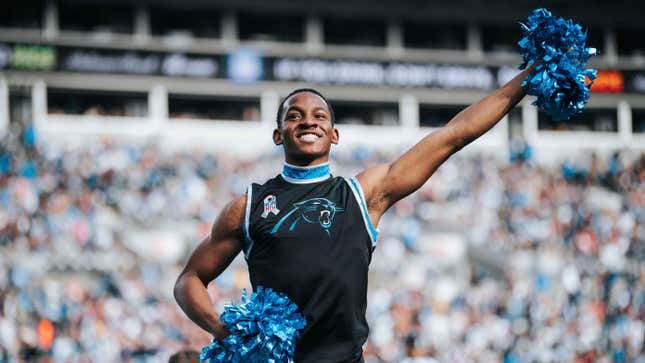

It’s Pride month, and for the NFL that typically means it’s time to splash a fresh coat of rainbow paint over the shield, publicize partnerships between LGBTQ+ organizers and the league’s first and only player to come out while in the NFL (though he is not currently employed by the league), and cash in on queer fans’ loyalty with Pride-themed games. For a league that’s facing constant revelations of misogyny and discrimination, the once-a-year celebration of queer people in the NFL has, regardless of good intentions, often felt more like a farce than a genuine tribute.
But there’s a different story unfolding in the South—one that subverts (or, at least, lessens the blow of) the threats to pregnant, queer, and trans people’s rights across the country and especially in southern states. The TopCats, the official cheerleading squad of the Carolina Panthers, have quietly become one of the most progressive organizations in the NFL. As one of the many faces of the team, Chris Crawford, a 23-year-old Black gay male who slides between femininity and masculinity as he pleases, is doing a hell of a lot of heavy lifting for gender identity diversity within a league that has glorified the gender binary since its inception. Crawford doesn’t care whether fans are ready for people like him to appear on their televisions and in their stadiums, because unabashed gender expression like his is the future. And the future, apparently, is the Carolina TopCats.
Crawford, who grew up in Macon, Georgia, started dancing in middle school and became a classically trained concert dancer, studying contemporary and ballet at the University of North Carolina School of the Arts. He loved cheerleading but didn’t see it as a realistic path after high school. In fact, he told Jezebel, he never had any intentions of becoming an NFL cheerleader until after he graduated college and realized his journey as a “little brown boy” who wanted to cheer wasn’t over yet.
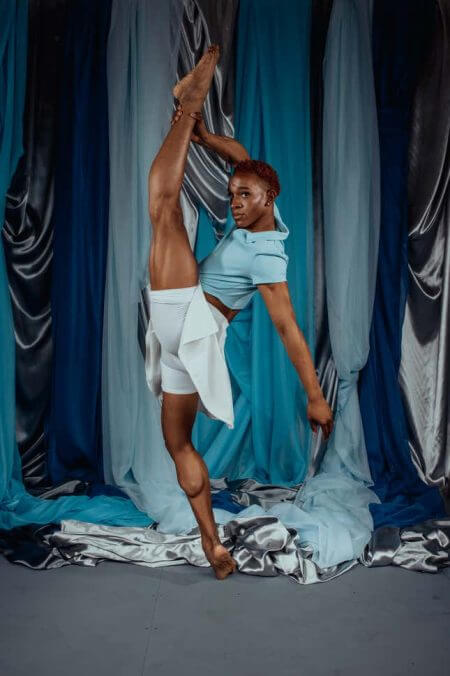
When Crawford showed up to the TopCat auditions in 2021 with now-teammate Tre’ Booker, he knew his chances were slim. No men had ever made the cut for the TopCats, though there’s been a spike in co-ed cheerleading squads in the NFL over the last five years. But Crawford and Booker became part of the first group of male cheerleaders on the Carolina squad, and Crawford, who auditioned in spandex shorts and his signature earrings, began challenging gender norms from the moment he stepped onto the sidelines.
As an organization, the TopCats has clearly given Crawford the space to be himself. On any given day, he might wear long, claw-like acrylic nails; a sports bra that matches those of his women teammates; more conservative tank tops; baggy, rhinestone-covered athletic pants; or false lashes. While Crawford identifies as a man, the manner in which he expresses his gender is fluid, depending on the day, his emotions, and the environment.
“I typically lean more into my feminine side just because growing up it was something I was always told had to be put in a box. It was something that had to be locked up: Guys don’t do this, guys don’t do that,” Crawford said. “Now I’m in a space where I’m surrounded by people that love the fact that this is who I genuinely am.”
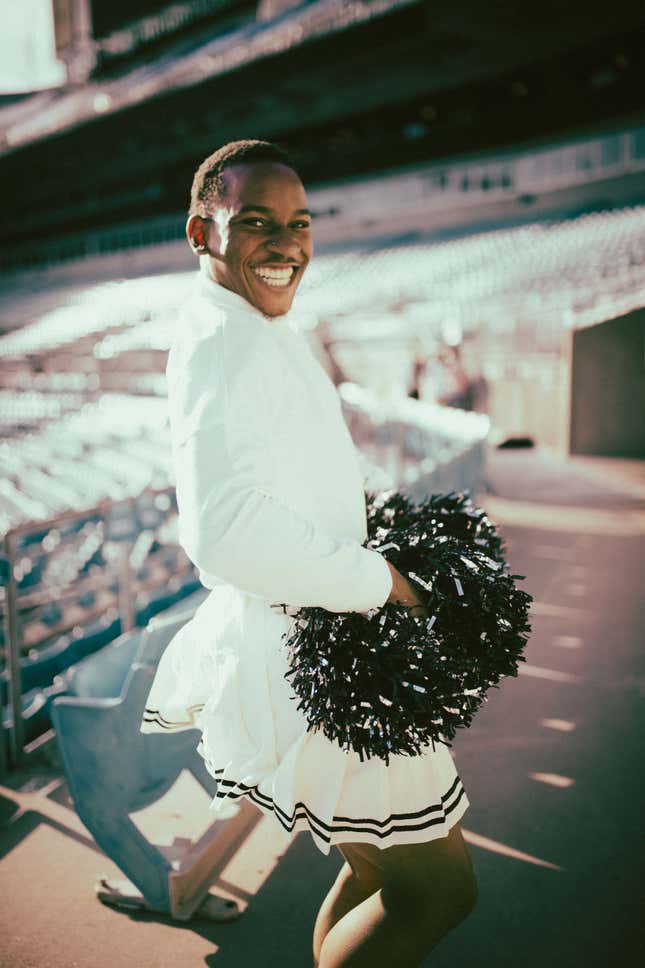
Crawford said that Chandalae Lanouette, the TopCats director, has enabled her cheerleaders to express themselves fully both on and off the job by fostering a safe space, something cheerleading has often struggled to be. She let the men choose whether or not they would hold pom-poms, despite nearly all other male NFL cheerleaders swinging rally towels, and whether they wanted to wear Panthers-branded sports bras or tank tops for auditions. The team also has a nail sponsor, and the male teammates are permitted to use the sponsor as long as their nails follow the rules and regulations (usually, light or team-colored nails, or french tips). And while the male teammates do wear pants and tanks on the field, they’re littered with crystals and even feature a turtleneck choker.
“Chandalae has created an environment for me here that is unmatched,” Crawford said. “Watering down who we are as individuals…whether people recognize it or not, affects the way we perform because at the end of the day, if you don’t feel comfortable in your skin, you’re not going to perform at your best.”
I’m going to be here, and I would rather be the first to catch this headstrong wave of energy so that it’s easier for others who come after me. This is just the beginning and these people will get used to it. They don’t have a choice.
NFL cheerleaders have long been expected to hide any traces of individuality, constraining expression of gender or sexuality that deviates from hetero norms in service of the larger uniformity of the team. This also means that the ideals of uniformity and tradition have been weaponized as excuses for excluding racially or gender-diverse people: same fluffed-up hair, same shaded abs, and, often, same skin color. But adding men to the team, as the Los Angeles Rams first did in 2018, threw a wrench in that perceived uniformity. (Disclosure: I was a Rams cheerleader at this time.) In a space that can veer homophobic, the safest bet was initially costuming male cheerleaders in line with a gender binary: The women would stick with their bedazzled miniskirts and crop tops, and the men would be put in something closer to a tracksuit to avoid presenting gender identities that fans weren’t accustomed to seeing. (That self was expected to stay at home or within the posts of personal Instagram profiles.)
Anne Lieberman, the director of policy and programs at Athlete Ally, said the different expressions of gender taking place within the TopCats, from trans teammate Justine Lindsay’s femininity to Booker’s and Crawford’s fluid identities, are integral to increasing the visibility of queer people. “There’s so many different ways to express femininity,” they said. “Just because somebody wants to dress more masculine one day doesn’t necessarily mean that they are a nonbinary person. …We need to be having more complex conversations about gender and gender expression.”
Along with the joy and purpose NFL cheerleading has brought Crawford, it has also placed him squarely in front of some of the Southern communities that hate queer people most, at a time when conservative legislators are vilifying the entire LGBTQ+ community.
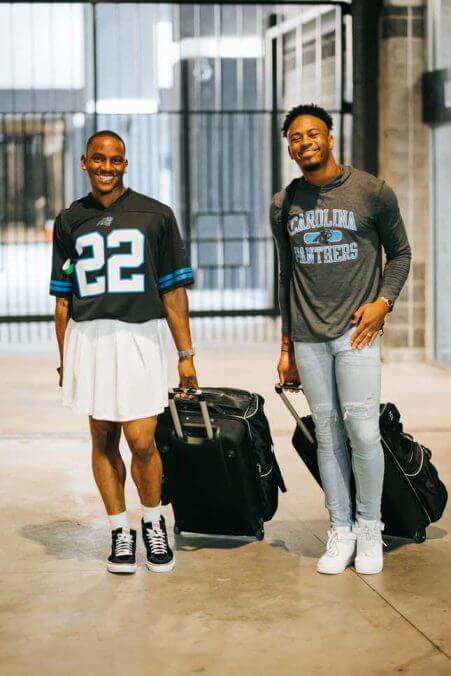
“To be a gay male cheering in the South, I won’t say it’s unbearable, but it is very emotionally strenuous,” Crawford said. “It’s hard for me to wake up some days and say, ‘OK, I have to do this appearance, and I already know how uncomfortable people are about to be around me.’” He often gets judgmental stares or is asked to photograph a fan with the women cheerleaders, as if he’s invisible or not a part of the team. Once, he did a photoshoot in the team’s stadium in a historical white cheer skirt, only to be met with chuckles and nasty comments from onlookers.
Crawford knows that by choosing to be unapologetically himself in this environment, he’s going to deal with ignorance, even though he shouldn’t have to. So, he smiles and maintains his composure, knowing it’ll blow over eventually—and that he can always raise issues with the Panthers if things get out of hand. It’s exhausting, he said, but he’d do it over and over again to lock down a better future for boys like him.
Lieberman said much of this hate is coming from the toxic masculinity that has been baked into football since its inception, in part because it’s a contact sport. They have observed a high level of desire and pressure to conform in spaces like the NFL to a very particular idea of masculinity. “We talk a lot about the pressure that cis women and trans women feel to be particular kinds of women, but we spend less time talking about the pressure for communities of men to be particular kinds of men, especially in men’s sports,” they said. “I think the more we have an understanding of more expansive ways to experience masculinity and manhood, then we’re gonna start to see a very big shift in sports culture.”
Of the fans who jeer at him, Crawford said, “I can’t sit and talk to you to explain to you that this is the future and that you need to get over it. I’m going to be here, and I would rather be the first to catch this headstrong wave of energy so that it’s easier for others who come after me. This is just the beginning and these people will get used to it. They don’t have a choice.”
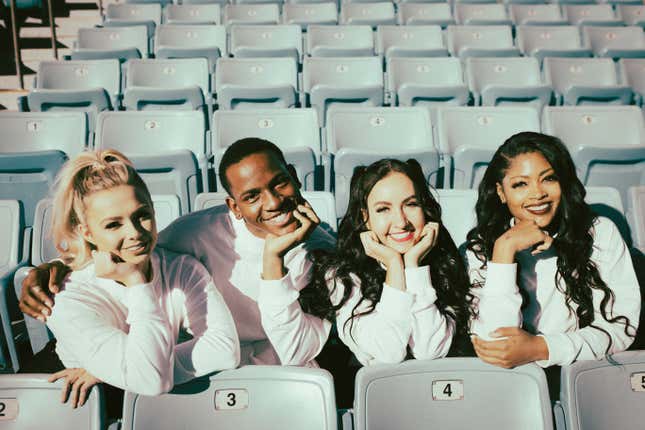
When he saw the final images from the stadium shoot (above), Crawford said he broke down crying. He knows there will always be backlash; that was a given from the start. But there wasn’t always someone like him or Booker or Lindsay in cheerleading. His struggle, and his bravery in the face of hostility, means that the next generation might not have to struggle so much—or at all. Looking at the photos, Crawford said he knew at that point that his presence on this team—one he calls family—is bigger than him. “It wasn’t just for me anymore. It was out of my hands,” he said. “This is for the world to see, for the world to know.”
There have long been arguments that the NFL doesn’t need cheerleaders—that feminism suffers as a result of dancers, regardless of talent, allegedly debasing themselves on the sidelines in service of the male gaze. But neither of those things are true. People can labor however they want to make a living, and the NFL does need cheerleaders—they might be the only window into real gender diversity and genuine self-expression on the field. And it certainly needs cheerleaders like Christopher Crawford, with or without the knit skirt.